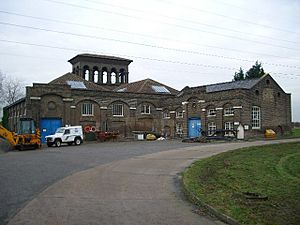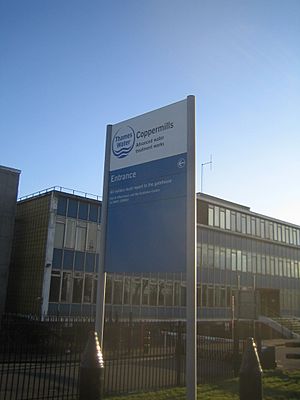Coppermill Stream facts for kids
The Coppermill Stream is a small river in Walthamstow, London. It's about 2 miles (3.2 km) long and flows into the River Lea. This stream is really important for nature, so it's a protected area!
Contents
Where Does the Coppermill Stream Flow?
The Coppermill Stream starts near the Lockwood Reservoir. It flows south, going under Ferry Lane and the Gospel Oak to Barking line. The stream then runs between the Walthamstow Reservoirs and the East Warwick Reservoir.
It passes by the old Coppermill and the Coppermills Water Treatment Works. After that, it flows next to Coppermill Lane and along the edge of Walthamstow Marshes. Finally, it goes under the Lea Valley lines and joins the River Lee Navigation near Springfield Park.
The Historic Coppermill
The stream gets its name from the Coppermill, a very old watermill. In 1808, a company called the British Copper Company bought it. They used the mill to process copper that came all the way from Swansea, Wales. This copper was then used to make penny and halfpenny coins! Copper production stopped in 1857.
The mill has a long history before making coins:
- In the 1300s, it ground corn.
- In the 1670s, it helped make gunpowder.
- By 1690, it was used for rolling paper.
- In 1712, it became a leather mill.
- Later, it made linseed oil.
In the late 1850s, the East London Waterworks Company bought the mill. They changed it to power a water pump. This pump helped them build reservoirs on the nearby marshland. Today, the Coppermill is owned by Thames Water.
How Coppermills Water Treatment Works Cleans Our Water
The Coppermills Water Treatment Works opened in 1969. It's owned and managed by Thames Water. This important facility is at the south end of the Lee Valley Reservoir Chain. In 2005, work began to connect it to the London ring main through a special tunnel. This was finished in 2009. Now, Coppermills is a major supplier of clean water for London!
How Water is Cleaned at Coppermills
The Coppermills treatment works gets raw (untreated) water from several places. It comes directly from the East Warwick, Low Maynard, and Walthamstow No. 5 reservoirs. It also gets water through a "Spine Tunnel" from the Lockwood, King George V, William Girling, and Banbury reservoirs.
Here's how they clean the water:
Step 1: Rapid Gravity Filtration
First, the water goes through rapid gravity filters. There are 24 large tanks with sand in them. Water flows down through the sand by gravity. This process takes about 15 minutes and removes tiny bits of dirt and particles. Every 6 to 24 hours, they clean these filters by pumping clean water and air upwards through the sand.
Step 2: Ozone Treatment
Next, Ozone gas is added to the water. Ozone helps to break down things like pesticides and other natural materials. It also kills harmful bacteria, making the water safer.
Step 3: Slow Sand Filtration
After ozone, the water moves to slow sand filters. There are 33 of these large beds at Coppermills. The top few millimeters of sand in these filters grow a special jelly-like layer called a biofilm. This biofilm is full of tiny living things like bacteria and fungi. As water slowly passes through this layer, these tiny organisms eat or trap any remaining dirt and contaminants. Over time, this biofilm gets thicker, and they have to drain the filter, scrape off the old biofilm, and add fresh sand.
Step 4: Screening and Chlorination
Finally, the water passes through very fine stainless steel screens. Then, chlorine is added to the water in special tanks. Chlorine is very important because it destroys any remaining harmful micro-organisms. Once the water is fully treated and safe, it is pumped into the distribution system. From there, it goes directly to homes or into large covered service reservoirs for storage.
Sometimes, tiny plants called algae grow a lot in the reservoirs. When this happens, it can make the rapid gravity filters work slower. This can reduce how much water the plant can clean each day. To help with this, a new plant was built in 2014. It has 12 more rapid gravity filters and can clean an extra 200 million litres of water every day!
Wildlife in the Stream
The clean water of the Coppermill Stream is a great home for many types of coarse fish, including the barbel.
Fun Activities
You can go angling (fishing) in the Coppermill Stream. Day tickets are available if you want to try!



